*LinkedBlockingQueue原理
基本的入队出队
java
public class LinkedBlockingQueue<E> extends AbstractQueue<E>
implements BlockingQueue<E>, java.io.Serializable {
static class Node<E> {
E item;
/**
* 下列三种情况之一
* - 真正的后继节点
* - 自己, 发生在出队时
* - null, 表示是没有后继节点, 是最后了
*/
Node<E> next;
Node(E x) { item = x; }
}
}初始化链表
java
//Dummy 节点用来占位,item 为 null
last = head = new Node(null);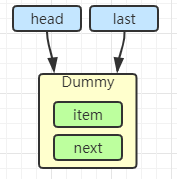
java
//当一个节点入队
last = last.next = node;
java
//再来一个节点入队
last = last.next = node;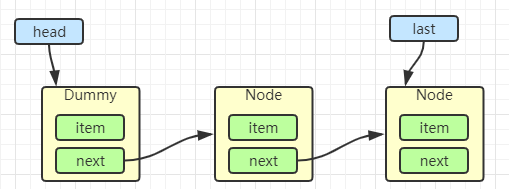
java
// 出队
public void out(){
//临时变量h用来指向哨兵
Node<E> h = head;
//first用来指向第一个元素
Node<E> first = h.next;
h.next = h; // help GC
//head赋值为first,表示first节点就是下一个哨兵。
head = first;
E x = first.item;
//删除first节点中的数据,表示真正成为了哨兵,第一个元素出队。
first.item = null;
return x;
}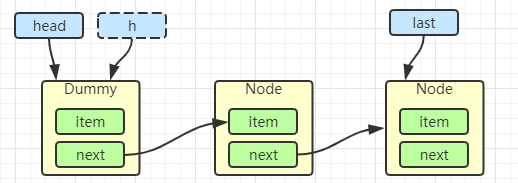
java
first = h.next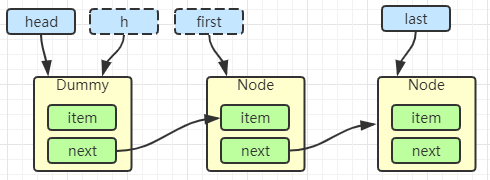
java
h.next = h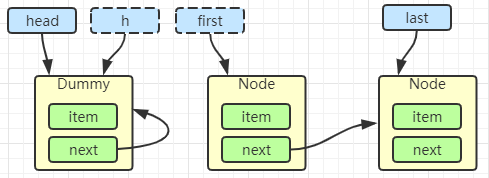
java
head = first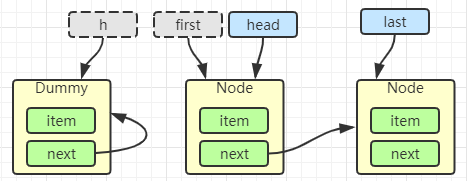
java
E x = first.item;
first.item = null;
return x;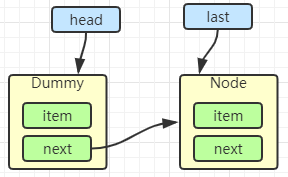
加锁分析
高明之处在于用了两把锁和 dummy 节点
- 用一把锁,同一时刻,最多只允许有一个线程(生产者或消费者,二选一)执行
- 用两把锁,同一时刻,可以允许两个线程同时(一个生产者与一个消费者)执行
- 消费者与消费者线程仍然串行
- 生产者与生产者线程仍然串行
线程安全分析
- 当节点总数大于 2 时(包括 dummy 节点),putLock 保证的是 last 节点的线程安全,takeLock 保证的是 head 节点的线程安全。两把锁保证了入队和出队没有竞争
- 当节点总数等于 2 时(即一个 dummy 节点,一个正常节点)这时候,仍然是两把锁锁两个对象,不会竞争
- 当节点总数等于 1 时(就一个 dummy 节点)这时 take 线程会被 notEmpty 条件阻塞,有竞争,会阻塞
java
// 用于 put(阻塞) offer(非阻塞)
private final ReentrantLock putLock = new ReentrantLock();
// 用户 take(阻塞) poll(非阻塞)
private final ReentrantLock takeLock = new ReentrantLock();put 操作
java
public void put(E e) throws InterruptedException {
//LinkedBlockingQueue不支持空元素
if (e == null) throw new NullPointerException();
int c = -1;
Node<E> node = new Node<E>(e);
final ReentrantLock putLock = this.putLock;
// count 用来维护元素计数
final AtomicInteger count = this.count;
putLock.lockInterruptibly();
try {
// 满了等待
while (count.get() == capacity) {
// 倒过来读就好: 等待 notFull
notFull.await();
}
// 有空位, 入队且计数加一
enqueue(node);
c = count.getAndIncrement();
// 除了自己 put 以外, 队列还有空位, 由自己叫醒其他 put 线程
if (c + 1 < capacity)
notFull.signal();
} finally {
putLock.unlock();
}
// 如果队列中有一个元素, 叫醒 take 线程
if (c == 0)
// 这里调用的是 notEmpty.signal() 而不是 notEmpty.signalAll() 是为了减少竞争
signalNotEmpty();
}take 操作
java
public E take() throws InterruptedException {
E x;
int c = -1;
final AtomicInteger count = this.count;
final ReentrantLock takeLock = this.takeLock;
takeLock.lockInterruptibly();
try {
while (count.get() == 0) {
notEmpty.await();
}
x = dequeue();
c = count.getAndDecrement();
if (c > 1)
notEmpty.signal();
} finally {
takeLock.unlock();
}
// 如果队列中只有一个空位时, 叫醒 put 线程
// 如果有多个线程进行出队, 第一个线程满足 c == capacity, 但后续线程 c < capacity
if (c == capacity)
// 这里调用的是 notFull.signal() 而不是 notFull.signalAll() 是为了减少竞争
signalNotFull()
return x;
}由 put 唤醒 put 是为了避免信号不足